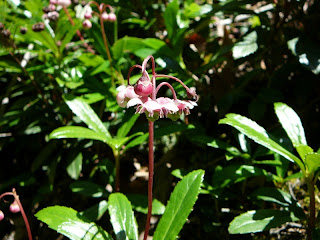6.22.12 Summer is here; the heat and the variety of flowers in bloom reinforced the calendar's denoting the season's change. New to me is the Yellow Avens (Geum aleppicum): when newly open and unpollinated, the stamens are yellow; as the seed capsule starts to enlarge, indicating pollination has occurred, the stamens turn brown, perhaps serving as a visual reminder to insects to seek out the new flowers.
Allegheny Vine (Adlumia fungosa) drapes over other vegetation; its dangling white-to-pale pink flowers remind us of Squirrel corn, and the lacy leaves contrast with the robust foliage of the young beech tree that supports it.
Spreading Dogbane, a close relative of milkweeds, is pollinated by butterflies; flies and other insects are attracted to its blossoms, but often are trapped and die if they get too close to the nectar source. As are most plants with "bane" in the name, it's not a good idea to ingest it.
Finally, we came across several Sassafras (S. albidum) young trees. Unlike most trees that can be identified by a single leaf shape, Sassafras has 3 different-shaped leaves.


















































